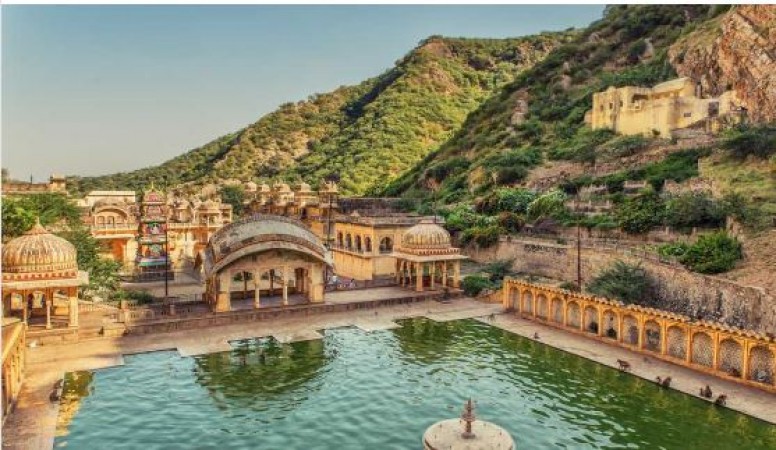
Galta Ji, also known as the Monkey Temple, is a prominent religious and cultural site located in the historic city of Jaipur, Rajasthan, India. Situated amidst the picturesque Aravalli Hills, Galta Ji is a fascinating complex of temples, water tanks, and sacred pools that attract thousands of devotees, tourists, and curious travelers every year.
The history of Galta Ji dates back to the 16th century when the site was established by Diwan Rao Kriparam, a courtier of the Rajput King Sawai Jai Singh II, the founder of Jaipur. The site was initially a small temple dedicated to the Sun God (Surya), and it gradually expanded under the patronage of the rulers of Jaipur. The temple complex was constructed over several centuries, with contributions from various rulers and devotees.
Also read: 5 Popular Temples In Andhra Pradesh
The Galta Ji complex is a remarkable architectural marvel that blends harmoniously with the surrounding natural landscape. The main temple, locally known as the Galta Ji Temple, is perched atop a hill and offers panoramic views of Jaipur. Built in the traditional Rajasthani architectural style, the temple's facade is adorned with intricately carved motifs and sculptures depicting Hindu deities and mythological figures.
The temple complex is a labyrinth of smaller temples, pavilions, and bathing ghats, all interconnected by a series of winding paths. The series of water tanks, collectively known as the Galta Kund, are a unique feature of this site. The most famous among them is the 'Surya Kund,' which is a large rectangular water tank, flanked by steps on all four sides. The Surya Kund is known for its natural springs that continuously fill the tank, creating a serene and peaceful atmosphere.
Also read: Varanasi: The Eternal City of Spiritual Enlightenment
Galta Ji holds immense religious significance for Hindus, particularly the followers of Lord Hanuman, the monkey god. It is believed that Saint Galav, after whom the site is named, performed severe penance at this location, and Lord Hanuman appeared before him. Consequently, the site became a revered spot for Hanuman devotees, and several shrines dedicated to Lord Hanuman can be found within the complex.
The temple complex is also associated with the renowned monkey population that resides there, giving rise to its popular name - the Monkey Temple. The monkeys considered sacred and believed to be the descendants of Hanuman, roam freely around the site, adding a unique and charming aspect to the place.
Also read: This Lake in Pakistan is Made of Mahadev's Tears, Unraveling the Legend
Galta Ji comes alive during religious festivals, with devotees flocking to the temple to seek blessings. Hanuman Jayanti, which commemorates the birth of Lord Hanuman, is celebrated with great fervor and enthusiasm. The temple premises are adorned with colorful decorations, and special rituals and prayers are performed throughout the day.
Another significant festival celebrated here is Makar Sankranti, which marks the transition of the sun into the zodiac sign of Capricorn. On this day, thousands of devotees take a holy dip in the sacred waters of the Galta Kund to wash away their sins and attain spiritual purification.
Also read: Jewel of Punjab: Exploring the Enigmatic Golden Temple
Galta Ji holds a unique place in the cultural landscape of Jaipur. It has not only been a center of religious devotion but also an important site for social interactions and community gatherings. The temple complex serves as a place for pilgrims to come together, share their beliefs, and celebrate their faith. The interaction between humans and monkeys at Galta Ji is an extraordinary cultural experience that draws tourists from all around the world.
Furthermore, Galta Ji has become an essential part of Jaipur's tourism industry. Visitors to the city make it a point to visit this iconic site to witness its grandeur, tranquility, and the playful antics of the resident monkeys. The influx of tourists has also boosted the local economy, with various small businesses, shops, and eateries catering to the needs of visitors.
Over the years, the popularity of Galta Ji has resulted in increased footfall, which has put pressure on its delicate ecosystem and heritage structures. The presence of monkeys has led to certain challenges in maintaining the cleanliness and safety of the site.
Also read: Unraveling the Mysteries of Kiyomizu-dera Temple: A Journey into Japanese Buddhism in Kyoto
To address these issues, various conservation and management efforts have been initiated. Local authorities and organizations are working together to preserve the site's natural beauty, enhance visitor experiences, and protect the historical structures. Measures have been taken to manage waste, provide proper facilities, and regulate visitor activities without disturbing the natural habitat of the monkeys.
Galta Ji in Jaipur is a mesmerizing blend of history, architecture, religion, and culture. It stands as a symbol of devotion, spirituality, and the coexistence of humans and nature. The enchanting Monkey Temple continues to captivate the hearts of people, serving as a spiritual retreat and a significant cultural landmark. With its timeless charm and religious allure, Galta Ji remains an indispensable part of the vibrant city of Jaipur, drawing both devotees and tourists alike to experience its magic and grandeur.
Also read: Engineering Marvels: The Hanging Pillar of Lepakshi Temple
The Legendary Temple of Solomon: Rediscovering Ancient Glory